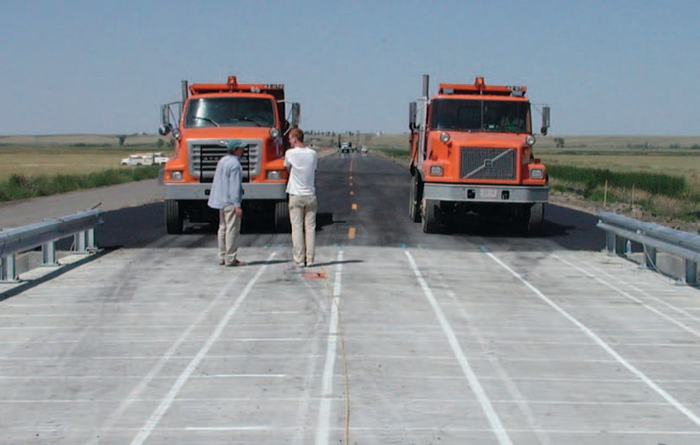
広大な農地と牧草地に囲まれたモンタナ州運輸局 (MDT) の橋梁設計者は、高速道路の橋床版設計を評価する絶好の機会だと気づきました。モンタナ州サコの小さな町の近くで、同じ高速道路回廊 (モンタナ州道 243 号線) に沿って 1 マイル未満の間隔で 3 つの橋が建設されました。その結果、各橋は天候、交通、冬季メンテナンスから同じ要求を受けることになります。各橋には 15 m のスパンが 3 つあり、全体寸法と下部構造コンポーネントが同じ鉄筋コンクリート デッキ オン プレストレスト ストリンガー設計が組み込まれています。それらの唯一の違いは、鉄筋コンクリート デッキの構成です。「従来型」デッキは、モンタナ州で使用されている標準的なデッキ、つまり標準的な鉄筋パターンの従来のコンクリートを表しています。「実験型」デッキも従来のコンクリートを使用していますが、鉄筋の量はおよそ 3 分の 1 です。「HPC」デッキは、高強度コンクリートを使用した標準的な鉄筋パターンを使用しています。 MDT は、モンタナ州立大学の西部交通研究所 (WTI) と契約し、計測システムの設計と設置、このシステムからのデータの取得、および 3 つの橋梁デッキのパフォーマンスを評価するためのその後の分析を実行しました。
計装
プロジェクトの計画段階では、3 つのデッキ構成について有限要素解析が行われ、橋のデッキ上でひずみゲージを配置する重要な場所が特定されました。この解析に基づき、計測機器は主に、各 3 径間橋の 15 メートル径間の 1 つの走行車線 (橋の約 1/6) に集中しています。ひずみゲージは、コンクリートを打設する前に各橋のデッキに設置されました。ゲージは、デッキの厚さの 3 つの異なる深さで縦方向と横方向のひずみを監視できるように配置されました。各橋では、3 つの異なるひずみゲージ技術が使用されました。鉄筋に接着された 35 個の Vishay 箔ひずみゲージ、コンクリートに吊り下げられた 7 個の Vishay 埋め込み型ひずみゲージ、およびコンクリートに吊り下げられた 16 個の Geokon バイブレーティングワイヤーひずみゲージです。さらに、イブレーティングワイヤーひずみゲージ内部のサーミスタによって 16 個の温度が記録されます。周囲の状況を監視するために、橋の建設場所から約 1 マイル離れたサコ公立学校に気象観測所が設置されました。気温、気圧、風速/風向、相対湿度の値は 15 分間隔で測定され、インターネットに投稿されて一般公開されます。
データ収集
すべてのひずみデータは、各橋の下に設置された単一の CR5000 計測および制御システムを使用して収集および保存されます。接着および埋め込みゲージには、WTI が設計および製造したホイートストン ブリッジ配置が必要です。対応する電圧は、単一の AM16/32 マルチプレクサを介してルーティングされます。バイブレーティングワイヤのひずみと温度は、AM16/32 マルチプレクサと結合された単一の AVW1 バイブレーティングワイヤ インターフェイスを使用して読み取られます。すべてのゲージは 1 時間に 1 回読み取られます。各橋からのデータは、サコ スクールにある RF400 拡散スペクトル無線のネットワークを介してインターネット経由で WTI に定期的に送信されます。気象データは、CR10X 計測および制御システムを使用して監視され、インターネット経由で直接 WTI に送信されます。
長期評価
Saco 橋床評価の主な目的の 1 つは、橋床の長期的な性能の比較分析です。この目的は、2 年間にわたる橋床の状態の定性的および定量的分析によって達成されます。理想的には、プロジェクトを数年間延長して、耐用年数全体にわたる相対的な橋床の性能をより完全に評価します。定性的分析には、亀裂マッピングと測量作業が含まれます。定量的分析は、主に、変化する気象条件や車両荷重イベントにさらされたときに橋床のひずみがどのように変化するかに焦点を当てています。デッキの状態を 1 時間ごとに監視することに加えて、ひずみゲージのサブセットが継続的にアクティブになり、「大型車両イベント」を捕捉します。ポータブル移動時重量測定 (WIM) 交通記録に対して較正すると、大型イベント データは、交通荷重によって橋にかかる累積的な要求を推定します。
実負荷試験
このプロジェクトの 2 つ目の目的は、3 つの橋のデッキの荷重支持機構を比較することです。この目的は、一連の活荷重テストによって実現されています。通行可能になる前に、重い荷物を積んだ車両が、各橋の全長にわたって、いくつかの異なる縦方向の経路に沿ってゆっくりと走行しました。各テスト イベント中、41 チャネルの鉄筋接合およびコンクリート埋め込みひずみゲージ データが記録されました。各橋のセンサーの数と高速データ取得速度に対応するために、活荷重テスト中は 3 台の CR5000 がすべて同時に使用されました。テスト中のトラックの縦方向の位置は、テスト トラックがデッキに沿って 2 メートルごとに移動するたびに作動する手持ちの電子ボタンによって記録されました。内部ひずみゲージによって記録された局所的なデッキひずみに加えて、Bridge Diagnostics, Inc. (BDI) によって提供された、ストリンガーの下部に一時的に固定されたゲージを使用して全体的な動作が監視されました。テストの大部分は、1 台のタンデム アクスル ダンプ トラックを使用して実施されました。 「最悪の場合」の挙動をシミュレートするために、2 台の車両が橋の全長にわたって並行して走行しました。また、1 台のトラックが時速 60 マイルで橋を横断する高速テストも実施されました。2 回目の活荷重テストは、橋が 2 年間使用されてから実施される予定です。
結果
現在、このレベルの詳細と変数の制御による橋床の挙動の比較調査は限られています。この研究は、鉄筋コンクリート橋床の局所的な挙動と、床と下部構造を通る荷重経路をより深く理解するためのユニークな機会を提供します。研究者と運輸部門は、車両荷重と変化する長期的な気象条件下での橋床の性能をより深く理解することで恩恵を受けるでしょう。この知識を応用することで、インフラストラクチャの健全性に関するより優れた計画と橋床の設計の改善につながります。
ケーススタディの概要
アプリケーション
実験用橋梁床版サイトの長期橋梁床版性能と活荷重試験場所
米国モンタナ州ソーコ使用製品
CR5000 AM16/32B CR10X RF400 NL100 AM16/32A寄稿者
Western Transportation Institute: Peter Smolenski, Jeff Johnson, Eli Cuelho, Jerry Stephens参加団体
モンタナ州運輸局(MDT)、西部運輸研究所計測項目
CR5000 デッキ性能: 歪み (接着箔、振動ワイヤ) 温度 (サーミスタ) CR10X 天候: 気温、風速、風向、気圧、相対湿度)関連ウェブサイト
Western Transportation Institute参加コンサルタント/インテグレーター
BDIPDFで見る